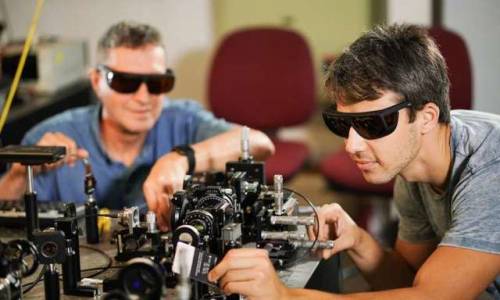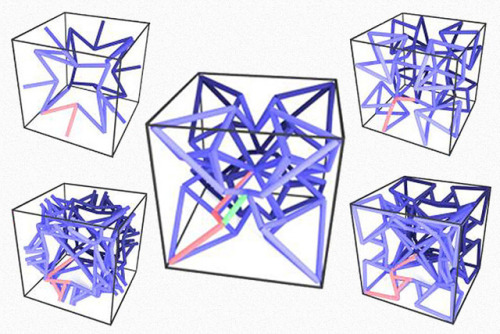#metamaterials
Newly developed material could lead to lighter, safer car designs
A new form of 3-D-printed material made by combining commonly-used plastics with carbon nanotubes is tougher and lighter than similar forms of aluminium, scientists say.
The material could lead to the development of safer, lighter and more durable structures for use in the aerospace, automotive, renewables and marine industries.
In a new paper published in the journal Materials & Design, a team led by University of Glasgow engineers describe how they have developed a new plate-lattice cellular metamaterial capable of impressive resistance to impacts.
Metamaterials are a class of artificially-created cellular solids, designed and engineered to manifest properties which do not occur in the natural world.
Post link
Applying metamaterials to quantum optics paves the way for new interdisciplinary studies
Two teams of scientists from the Technion-Israel Institute of Technology have collaborated to conduct groundbreaking research leading to the development of a new and innovative scientific field: Quantum Metamaterials. The findings are presented in a new joint paper published in the journal Science.
The study was jointly conducted by Distinguished Professor Mordechai Segev, of Technion’s Physics Department and Solid State Institute and his team Tomer Stav and Dikla Oren, in collaboration with Prof. Erez Hasman of the Technion’s Faculty of Mechanical Engineering and his team Arkady Faerman, Elhanan Maguid, and Dr. Vladimir Kleiner. Both groups are also affiliated with the Russell Berrie Nanotechnology Institute (RBNI).
The researchers have demonstrated for the first time that it is possible to apply metamaterials to the field of quantum information and computing, thereby paving the way for numerous practical applications including, among others, the development of unbreakable encryptions, as well as opening the door to new possibilities for quantum information systems on a chip.
Metamaterials are artificially fabricated materials, made up of numerous artificial nanoscale structures designed to respond to light in different ways. Metasurfaces are the 2 dimensional version of metamaterials: extremely thin surfaces made up of numerous subwavelength optical nanoantennas, each designed to serve a specific function upon the interaction with light.
Post link
Ancient Arts of Origami and Kirigami Inspire Mechanical Metamaterials
Origami- and kirigami-based metamaterials have applications from robotics to medical devices.
The ancient arts of origami, the art of paper-folding, and kirigami, the art of paper-cutting, have gained popularity in recent years among researchers building mechanical metamaterials. Folding and cutting 2D thin-film materials transforms them into complex 3D structures and shapes with unique and programmable mechanical properties.
In Applied Physics Reviews, by AIP Publishing, researchers in the United States and China categorize origami- and kirigami-based mechanical metamaterials, artificially engineered materials with unusual mechanical properties, into six groups based on two different criteria.
“Origami and kirigami are, by nature, mechanical metamaterials, because their properties are mainly determined by how the crease patterns and/or cuts are made and just slightly depend on the material that folds the origami or kiragami,” said author Hanqing Jiang.
Post link
Drones and Cars Could Benefit from a Way to Shrink Radar Equipment
“Metamaterials provide a way to get around many of the physical limitations that have previously defined how engineers could control radio, light, and sound waves. For example, while conventional lenses need their characteristic shape to bend light rays into focus, a metamaterial lens can bend light the same way while being perfectly flat.
Metamaterials are made from repeating structures that are smaller than the wavelength of the electromagnetic radiation being manipulated. Echodyne makes its metamaterials by tracing out repeating patterns of copper wiring on an ordinary circuit board.
A board with multiple layers of such wiring can direct radar beams. And applying different voltages to some parts of the wiring makes it possible to actively control the beam as a phase shifter would. “Any printed circuit board manufacturer could produce these,” says Driscoll.
The radar systems used by the military typically start at around $100,000, says Eben Frankenberg, CEO and another cofounder of Echodyne. He says his company hopes to mass produce compact radar systems that cost only hundreds or thousands of dollars.
Driscoll says that could make scanning radar become a standard sensor for vehicles and robots. Some prototype autonomous cars, including Google’s, use spinning laser sensors to watch the world around them in 3-D. That technique can map the world in very high resolution, but its range decreases in fog or snow. Radar doesn’t have that limitation, says Driscoll.”
Post link
Are Invisibility Cloaks Possible?By Reactions
Have you ever wished you could hide under an invisibility cloak like Harry Potter or conceal your car with a Klingon cloaking device like in Star Trek? In a special bonus episode of Reactions, we celebrate the International Year of Light by exploring the science behind light, sight and invisibility. Though we can’t make ourselves invisible yet, some promising research may light the way – or rather, bend the light away.
This Slinky lookalike ‘hyperlens’ helps us see tiny objects
It looks like a Slinky suspended in motion.
Yet this photonics advancement – called a metamaterial hyperlens – doesn’t climb down stairs.
Instead, it improves our ability to see tiny objects.
Described in a research paper published today by the journal Nature Communications, the hyperlens may someday help detect some of the most lethal forms of cancer.
It could also lead to advancements in nanoelectronic manufacturing and boost scientists’ ability to examine single molecules – a development with implications in physics, chemistry, biology and other fields.
“There is a great need in health care, nanotechnology and other areas to improve our ability to see tiny objects that elude even the most powerful optical systems. The hyperlens we are developing is, potentially, a giant step toward solving this problem,” says Natalia Litchinitser, PhD, professor of electrical engineering at the University at Buffalo and the paper’s lead author.
Post link
Engineers Develop Automated Process for Discovering Optimal Structure for Metamaterials
For decades, materials scientists have taken inspiration from the natural world. They’ll identify a biological material that has some desirable trait — such as the toughness of bones or conch shells — and reverse-engineer it. Then, once they’ve determined the material’s “microstructure,” they’ll try to approximate it in human-made materials.
Researchers at MIT’s Computer Science and Artificial Intelligence Laboratory have developed a new system that puts the design of microstructures on a much more secure empirical footing. With their system, designers numerically specify the properties they want their materials to have, and the system generates a microstructure that matches the specification.
The researchers have reported their results in Science Advances. In their paper, they describe using the system to produce microstructures with optimal trade-offs between three different mechanical properties. But according to associate professor of electrical engineering and computer science Wojciech Matusik, whose group developed the new system, the researchers’ approach could be adapted to any combination of properties.
“We did it for relatively simple mechanical properties, but you can apply it to more complex mechanical properties, or you could apply it to combinations of thermal, mechanical, optical, and electromagnetic properties,” Matusik says. “Basically, this is a completely automated process for discovering optimal structure families for metamaterials.”
Post link
Integrated metasurface converts colors of light over broadband inside a waveguide
One of the biggest challenges in developing integrated photonic circuits—which use light rather than electrons to transport information—is to control the momentum of light. Colors of light travel at different speeds through a material but in order for light to be converted between colors, it needs to have the same momentum or phase.
Many devices have been designed to momentum-match or phase-match light at various points throughout an integrated circuit but what if the phase-matching process could be circumvented all together in certain cases?
Researchers at the Harvard John A. Paulson School of Engineering and Applied Sciences, together with collaborators from the Fu Foundation School of Engineering and Applied Science at Columbia University, have developed a system to convert one wavelength of light into another without the need to phase match.
The research was published in Nature Communications.
“For any wavelength conversion process to be efficient, it has to be carefully designed to phase match, and it only works at a single wavelength,” said Marko Loncar, the Tiantsai Lin Professor of Electrical Engineering at SEAS and senior author of the paper. “The devices shown in this work, in contrast, do not need to satisfy the phase-matching requirement, and can convert light in a broad colorrange.”
Post link
Silk Fibers May Represent Natural Metamaterials, Capable of light Confinement
New research has demonstrated how the nano-architecture of a silkworm’s fiber causes “Anderson localization of light,” a discovery that could lead to various innovations and a better understanding of light transport and heat transfer.
The discovery also could help create synthetic materials and structures that realize the phenomenon, named after Nobel laureate Philip Anderson, whose theory describes how electrons can be brought to a complete halt in materials due to their “scattering and defects.” The new findings relate not to electrons, but to light transport.
Researchers demonstrated how the nano-architecture of the silk fibers is capable of light “confinement,” a trait that could provide a range of technological applications including innovations that harness light for new types of medical therapies and biosensing. This light-confinement effect in biological and natural tissue, which was unexpected, is made possible by the Anderson localization of light, said Young Kim, an associate professor in Purdue University’s Weldon School of Biomedical Engineering.
The new findings suggest silk fibers may represent “natural metamaterials” and “natural metastructures,” Kim said.
Post link
Zero-index metamaterials offer new insights into the foundations of quantum mechanics
In physics, as in life, it’s always good to look at things from different perspectives.
Since the beginning of quantum physics, how light moves and interacts with matter around it has mostly been described and understood mathematically through the lens of its energy. In 1900, Max Planck used energy to explain how light is emitted by heated objects, a seminal study in the foundation of quantum mechanics. In 1905, Albert Einstein used energy when he introduced the concept of photon.
But light has another equally important quality, known as momentum. And as it turns out, when you take momentum away, light starts behaving in really interesting ways.
An international team of physicists led by Michaël Lobet, a research associate at the Harvard John A. Paulson School of Engineering and Applied Sciences (SEAS) and Eric Mazur, the Balkanski Professor of Physics and Applied Physics at SEAS, are re-examining the foundations of quantum physics from the perspective of momentum and exploring what happens when the momentum of light is reduced to zero.
The research is published in Nature Light: Science & Applications.
Post link
Invisibility cloak with photonic crystals
Metamaterials made from metal elements initially proposed for constructing invisibility cloaks, did not solve some important cloaking problems.
There are three challenges remaining. The first is controlling anisotropy – the variable behavior of propagating waves in different directions of the cloak medium. It’s also important to make sure that the cloak materials can operate at microwave and optical wave frequencies. Finally, researchers have to decrease losses that restrict the size of hidden objects.
Elena Semouchkina, an associate professor of electrical and computer engineering, and her graduate students have developed several novel approaches to making invisibility cloaks more practical. Their latest work, published in a special issue of Journal of Optics on transformation optics, looks at a promising new way to manipulate electromagnetic waves to make objects appear invisible. The team developed an approach using photonic crystals.
Post link
Harvard researchers have designed a new type of foldable material that is versatile, tunable and self actuated. It can change size, volume and shape; it can fold flat to withstand the weight of an elephant without breaking, and pop right back up to prepare for the next task.










